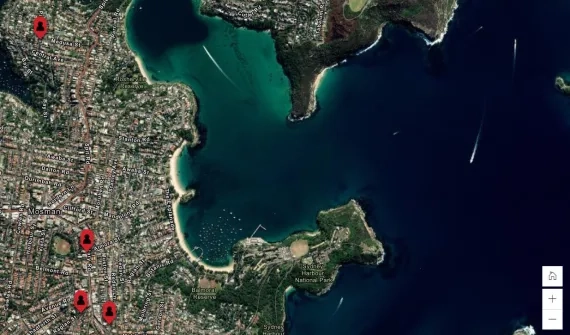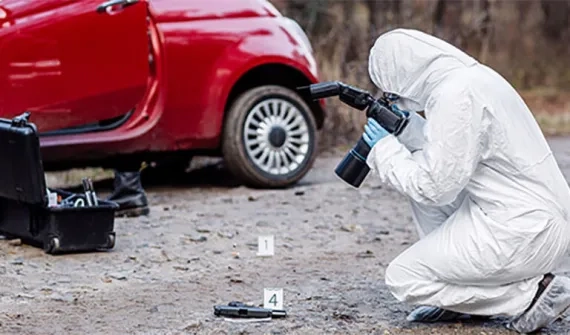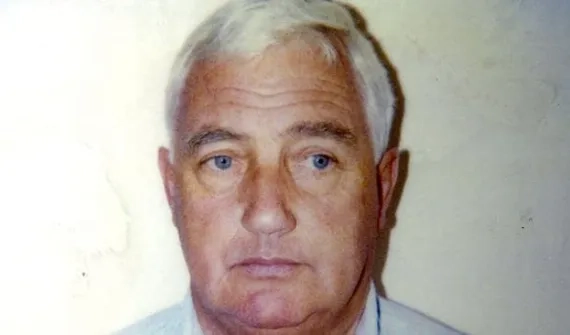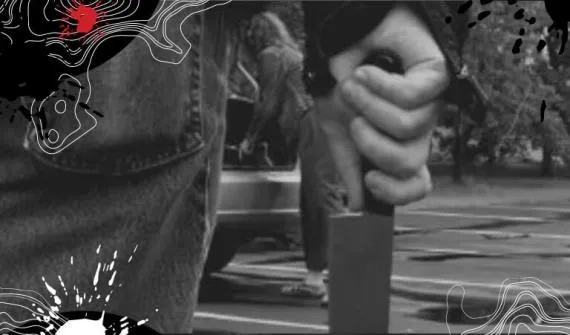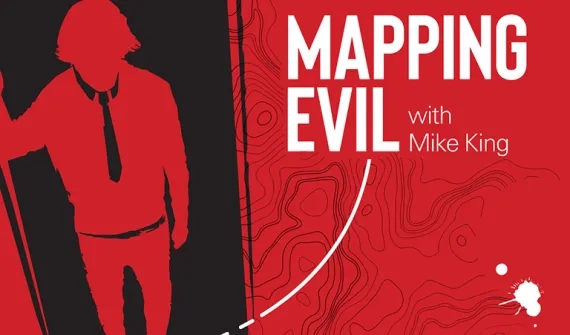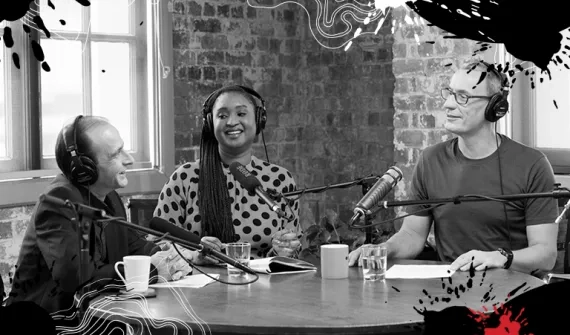Hunting the hunters
Even for seasoned investigators like Mike King, crimes against the most vulnerable members of society – such as those in their twilight years – are amongst the most difficult to comprehend.
In a jailhouse interview with serial killer Daniel Ray Troyer – a man who is suspected of brutally murdering at least 13 elderly women – Troyer posed this very question to Mike, asking: “You’re having a hard time understanding this aren’t you?”
In this episode of Mapping Evil, Mike King and Tory Shepherd look at the crimes of America’s Daniel Ray Troyer and Australia’s own ‘Granny Killer’ – John Wayne Glover. Mike looks closely at the circles the men moved in, their bizarre rituals, and the eerily similar geographies of their favourite hunting grounds.
Join Mike and Tory for another no-holds-barred journey into the dark side of humanity.
Troyer said, “I only have one choice. I would have to kill my mother, so I don't break her heart. Then I can kill my brother-in-law.”
The geography of crimes against the elderly
Explore crime mapping tech
Never miss an episode of Mapping Evil – subscribe now.
About the hosts

If you have information about any unsolved crime or suspicious activity, then you can share what you know with Crime Stoppers, without saying who you are or getting involved. Call 1800 333 000 – or go to crimestoppers.com.au.
- Click to view the Twilight Zones transcript
Tory Shepherd: The following podcast contains content of a highly graphic nature. Listener discretion is advised. The material covered is based on firsthand accounts and publicly available information. In producing this podcast, every effort has been made to show respect to the victims and their families.
Support for this episode comes from the country's leading mapping technology and services provider, Esri Australia. To learn more about how Esri tech is making a difference in crime analysis and public safety, head to esriaustralia.com.au/crime.
Mike King (voiceover): Elderly are being preyed upon by serial predators.
Tory Shepherd: I'm Tory Shepherd. And this is Mapping Evil with Mike King.
Mike King (voiceover): This is a serial killer who, some people think, is responsible for maybe 13 murders.
Tory Shepherd: The podcast that explores the geographic footprint behind crimes of horrific natures.
Mike King (voiceover): It was still a process of digitally putting a pin on the map and by visualising the location, they would start to see some patterns emerging. He would put them in their bed and make it look like it was a natural-cause death – and no autopsy was performed, so he gets away with it.
Tory Shepherd: Episode Four: Twilight Zones.
Mike King (voiceover): He said, “I only have one choice. I would have to kill my mother so I don't break her heart. Then I can kill my brother-in-law.” That's the psychopathy of a serial killer.
Tory Shepherd: Mike King has spent his life exploring the darker side of humanity. He's trained with members of the FBI to become a world-renowned criminal profiler.
He's also written multiple books, runs his own YouTube channel and has pioneered the use of Geographic Information System (GIS) technology in law enforcement. Over the years, Mike has sat face-to-face with abusers, rapists, and murderers to try and understand how they choose their victims and why.
Today, we're going to talk about an unusual breed of predator – one whose crimes specifically target the most vulnerable, elderly members of our society.
We're going to start with Daniel Ray Troyer. You met him in prison, Mike. Tell us what Troyer had done and what it was like meeting him.
Mike King: Daniel Troyer was really interesting because this is a serial killer who, some people think, is responsible for maybe 13 murders. There are eight that I'm aware of that he committed, but the peculiar thing about his particular victim selection process was that he looked for elderly women. There were a number of reasons he did that. One was that they were more easy to control, more easy to isolate, but there are also some darker reasons.
I had just completed a study for the Bureau of Justice with my partner at the time, Greg Cooper. We had travelled throughout the United States, talking to serial killers who were responsible for killing more than one elderly person in order to fit our criteria. We looked at the motivation behind the murders, the motivation behind the way in which they committed the murders, the victim selection process and the personal interactions that the offenders had with the victims.
It's kind of weird to think about this idea of personal interaction, but it becomes very complex. This idea that elderly are being preyed upon by serial predators really is not that unique. We found there were a large number during and since that study. I've had contact with investigators all around the world who have investigated like-cases.
Tory Shepherd: Talk us through his buildup, I guess.
Mike King: It's interesting as we think about it, because he went out and he selects this 70-year-old quadriplegic. The reason he selected her was not because it was necessarily stimulating to him sexually or anything else. This was his first crime that we know of and the first that he openly confesses to – but the thing that's so intriguing about this is that he selects someone who's physically handicapped and not able to fight back in any way. So it ensures his success in that particular case.
The one thing I found really interesting about his particular case was we later learned from one of his cellmates in prison that he said the biggest mistake he made in that particular assault was leaving her alive. He said “I will never leave a victim in a position to report me again.” What a bone chilling statement.
Tory Shepherd: You're right. That just went right up and down my spine. Tell us a bit more about where he was. We're talking Salt Lake City, Utah. He has a hunting ground. Is that how this works?
Mike King: If we look at serial predators – kind of like we would look at animal predators – we have to take into account that they're going to hunt where they're going to be successful. As long as they're successful and they're not being frightened off by law enforcement – or for an animal, a predator of greater power – they're going to continue to hunt in an area they're familiar with, that they understand, that they know the back alleys to. This individual was very much the same.
He comes out of prison. The next thing he does almost immediately – and I think it was just within a matter of days – is he seeks out a 54-year-old woman named DeEsta Easthope. The thing that was so intriguing about her is that this woman was actually the mother of one of his cellmates in prison – a guy named Ronnie Easthope who was dubbed the ‘Sugar House Rapist’ and had gone to prison for the rest of his life.
Tory Shepherd: And then they escalate. If we take that hunting metaphor, he's picked on helpless prey – the quadriplegic that he assaults – comes out of prison and attacks somebody else. Is he gaining in confidence? Is that that's what's happening? He knows the area. He knows what he's looking for.
Is he checking out women walking along on walking sticks? How's he using the territory to work out who his next victim is?
Mike King: That's really interesting because in Mrs. Easthope's case, he actually started fantasising about her and killing her long before he was released from prison. He used to sneak through Ronnie's letters from his mother and read those and fantasise that he was having this relationship because he never had a real family relationship himself.
As soon as he gets out of prison, the first thing he does is he goes and hunts her. If we think back to the first victim that he had: “I'll never leave a victim in a position to report me again”. He goes inside after greeting her, telling her his name. She obviously lets him into the house because she thinks 'this is a cellmate of my son'.
She knew who he was because they had talked and conversed when there were prison visits. He immediately attacks her in this blitz-style attack. He does it from behind – as she's walking into the kitchen, he comes up behind her and then chokes and kills her.
One of the crazy things that Troyer did – that really started to become a signature of his – was that he would then spend time with the victim once they were deceased. He would undress them, oftentimes bathe them, and there was clear indications of sexual activity and other things.
But then he did something really intriguing. He would put them in their bed or in a bathtub and make it look like it was a natural cause death. In her case, he put her in her bed and a short time later her family and husband found her and assumed that she had simply died in her sleep and no autopsy was performed. So he gets away with it for a period of time until he later confesses.
Tory Shepherd: How did he actually get busted?
Mike King: Well, he then goes on and immediately assaults another woman – a 69-year-old woman named Thelma Blodgett. Again, the family discovers her – this time in the bathtub. Her death too is treated like a natural cause death but when they get her to the mortuary to start preparing her body for burial, a mortician discovers strangulation marks on her neck. That brings police back to take this case and start to look at it as a homicide rather than just a natural causes death.
Now he's starting to really ramp up and we see him within seven days take his next victim – which is an 83-year-old woman named Drucilla Ovard. Again, it’s a very similar kind of blitz-style attack – he also strangles her from behind – but his confidence is starting to grow.
When he confesses, he says he's now ready to start looking into the eyes of his victim as he kills them. Now he's facing the victim head-on and looking into their face as he strangles them to death. Her body is found in the bathtub and she's treated as a natural cause death as well.
This transition is really intriguing because we see him starting to gain confidence, but more importantly, what we're starting to see is he's going from what we might consider to be a more organised approach to starting to show some disorganisation.
Tory Shepherd: So you've got older people found dead and eventually they work out this isn't just a natural death how did all of that lead to him?
Mike King: A burglary detective was looking at Daniel Troyer for a house burglary and Troyer starts feeling the heat. Before I give you the answer to that, I want to just touch on two other deaths that he's responsible for. He finds an 88-year-old woman named Ethel Luckau sneaks over to her house, kills her and leaves her, and her death also is determined to be a natural-causes death.
Less than a week later, he assaults another 88-year-old woman named Lucille Westerman – who's strangled and left for dead. But this poor gal actually lives for three weeks before she eventually dies. As all of this is happening, the burglary detective reaches out and corners Troyer and says to him, “hey, I've got the goods on you”. And he's thinking “I got the goods on you for a house burglary” but Troyer thinks that they've got him on the murders and he confesses to the murders.
Tory Shepherd: Let's go back to Salt Lake City. Is there a way now that you would've been more easily able to track 'that was there and this attack was over here' and map that out so that you get the pattern emerging earlier.
I'm asking that not to say, ‘somebody should have solved it earlier’ but if I was in Salt Lake City and my elderly parent had died in a similar area, I'd be wanting to know 'aren't, you kind of mapping this guy who seems to have a territory that he works within?'
Mike King: In those days, the pin mapping that was going on honestly was sticking a pin in the map and trying to then tie those pins to each other. It was often done with yarn and other kinds of things as we started to put it together. This was just in the beginning days when we were starting to use GIS and using maps – and City of Salt Lake was one of those in the forefront. It was still a process of digitally putting a pin on the map instead of today where so much is done in a very automated way – back then they were physically putting the points where those crimes were occurring.
By visualising the location, they would have started to see patterns emerging. They would have been able to look at things like public transportation and other things that are important in moving from one place to another.
One of the things we have at our fingertips today that makes it easy to interrogate and understand, is electronic data of things like parolees and probationers who were on paper for sexual assaults, homicides or burglaries. If then we could have – and hindsight's so wonderful – but if we could have been able to see who were the recent parolees and what was their victim selection process like? They could have quickly identified that here's a guy who just came out of prison. Then all of a sudden, all these old ladies start turning up dead.
Tory Shepherd: I imagine today then if there was a pattern emerging like that, they'd ask every death to be more closely investigated if it was in a small place like that.
Mike King: You're absolutely right. And the thing that gets so intriguing to investigators – and to everyone – is how could someone in their right mind do this? Well, number one, they're not in their right mind because of their psychopathology and the fact that they think killing people is a good idea.
I wanted to just share a comment that Troyer made to me one day in the prison, as we were talking. I leaned back in my chair and he said “you're having a hard time understanding this aren't you? Well, let me put it to you this way. Let's say you hate your brother-in-law.” And then he paused. “Which incidentally I do hate my brother-in-law.”
He said, “But my mother loves my brother-in-law. In my mind, I hate my brother-in-law so much that I want to kill my brother-in-law. But I know how much that would hurt my mother if I killed him because she loves him so much.”
He said, “How do I resolve my dilemma, Mike?” The only way that psychopath could solve the problem was he said “I only have one choice. I would have to kill my mother, so I don't break her heart. Then I can kill my brother-in-law.”
Tory Shepherd: Then he's looking for substitute mothers.
Mike King: Yeah, that's the psychopathy of a serial killer.
Tory Shepherd: The next territorial predator that we're going to talk about today is John Wayne Glover.
Tell us about him because he was living on the rich North Shore of Sydney when he killed a lot of people. He was a pie salesman, he always went to the same RSL. So he was sticking to a beat wasn't he?
Mike King: You know, he did end up in that very upscale part of Sydney but before that, this was just a commoner. He actually hails from England and dating back to his youth he had a lot of petty crimes against him for theft and robberies that were just what we call ‘strong armed robberies’ in the States – grabbing a purse or something and running away with it.
He drops out of school at a young age, and he joins the army. We see this sometimes with people trying to have this ‘macho’ kind of attitude – but he gets dishonourably discharged from the British army very quickly for more theft crimes. Somehow he figures out how to emigrate to Australia in 1957...
Tory Shepherd: Oh Mike, in 1957, we would let anyone in. We called them the ’10-pound poms’ – they paid 10 pounds to sail over here from England. We needed a lot of workers. We were setting up a lot of factories around the place and you could bring your whole family over and basically just grab a big bit of land in Australia.
Mike King: You are much more careful today – I can say having had the opportunity to work with your law enforcement across the country.
Once Glover gets into Melbourne he gets convicted of a couple of more things and gets convicted of several counts of larceny in Victoria.
Then we see him starting to escalate a little bit. By 1962, he's getting convicted for sexual assaults of women, indecent exposure and attempts to commit bodily harm. This guy is starting to progress and emerge as a problem.
He then meets this light of his life, and her parents invite them to come and live with them in this upscale neighbourhood in the Sydney metropolitan area in Mosman.
There, all of a sudden this kid from the sticks in England is feeling like he's among the rich and wealthy living in this area. For a very short period of time everything seems to be going well, but he starts to have some problems with family dynamics and other kinds of things.
Tory Shepherd: I wonder if he felt as though he's married above his station. He is this scruffy guy from Wolverhampton who is now is in this very posh area, living in a posh house, with a posh mother-in-law who maybe didn't think that he was good enough for her little daughter?
Mike King: Yeah, that seems to be a resonating theme for the rest of his life, doesn't it. He ends up having to take this travelling salesman job, selling pies around the region. I suspect that the mother-in-law was constantly saying “Why can't he provide? He's living in our house.”
Tory Shepherd: Right. As a pie salesman back then you were literally just driving around to different places, taking orders and dropping off orders. This guy is building resentment, particularly towards older women – because he didn't like his mum much either but now he hates his mother-in-law. He has the opportunity to drive around different places all in the same area – that lovely North Shore – and has a reason to be well, he went to nursing homes, right?
Mike King: Yeah, that's really interesting. Then he ends up volunteering even at, I think it's called the Senior Citizens’ Society.
About the time he's doing this, he suddenly experiences a whole bunch of tragedy in his personal life. His mother gets breast cancer and dies. He gets breast cancer. Now that's relatively rare for men, and it results in him having some additional kinds of problems. In fact, I think he even had to have his testicles removed and some other things, so he starts to…
Tory Shepherd: You can see how he's starting to feel emasculated.
Mike King: Yeah. That's really interesting, isn't it? We in the profiling world talk about that as being a ‘triggering event’ – where things start to happen. To add insult to the injury, his wife then takes their two daughters, files for divorce, and moves to New Zealand and all of a sudden this guy is on his own and he's filled with anger and frustration and doubt and fear. Then we start seeing his crimes start to happen.
Tory Shepherd: Talk us through that. With all these serial predators you start to see both a geographical and a demographic pattern emerge. Geographically, it was the nice North Shore suburbs of Sydney – very leafy, very affluent – and demographically, it was older women. Maybe who looked a little bit like his mother-in-law?
Mike King: That's been a really interesting question and I haven't seen a picture of his mother, but he’s a 56-year-old man at this point. In most cases, we don't look at someone at that age – or even older into my age – and feel in any way threatened by them.
All of a sudden, he starts to really focus in on elderly women. Now we start to think – and may have been influenced by some of the psychologists and others who have suggested this – this is tied to his mother-in-law and an anger that he's feeling, and the loss of his mother and maybe some resentment with his mother regarding this cancer that he now is facing. And all of a sudden, he starts going out and hunting for elderly victims.
Tory Shepherd: I don’t know if you've been to Mosman or around that area. I think the leafy suburbs people would think, 'Oh, that wouldn't happen to people here' so that they may be wary because he started following some women home.
Mike King: That's exactly right Tory. I have been to those areas – I've been able to work with law enforcement all throughout Australia. I've had the opportunity to go into each of those communities in the major cities in every state and I've been able to get a feel of things and a sense of the environment.
When I looked on the maps as we started plotting out where all of these homicides occurred, it was really kind of nice because I recognised landmarks. I recognised where I caught the train to go up to the mountains and enjoy a Sunday afternoon.
In 1989, all of a sudden we have a pre-murder event, where Glover robs a woman named Margaret Todd Hunter and he gets $209. This is an aggravated robbery where he physically assaults her and takes her money. This interesting signature happened in the way he assaults. We see an interesting signature mark and what he does every time he gets the money – I think you've read up a little on that haven't you?
Tory Shepherd: Yeah, he goes straight to the pokies – you call them slot machines, Mike – at the RSL club, which is the Returned Servicemen’s League. This is not an uncommon place to go. I read that he possibly got a thrill out of murdering an elderly woman, taking a fairly insubstantial amount of cash from her, then going down to the RSL and buying drinks for other older women there.
Mike King: This is one wacky guy.
Tory Shepherd: He quickly created that habit of 'I go here and then I go here' which I found really interesting, because you would think he'd be thinking 'I shouldn't set a pattern because the guys with their little pin maps, they're going to work it out' but he was driven to.
Mike King: Sadly in this case it took a long time to work it out because he then shortly after, it appears assaults a woman named Florence Broadhurst – a 78-year-old artist.
Tory Shepherd: A name that will be very familiar to Australians – she's still quite well-known today.
Mike King: Why is that?
Tory Shepherd: She's quite a famous designer. He was moving in some pretty high circles, actually. Maybe it's just being in Mosman but normally a man like Glover wouldn't come into contact with a woman like Broadhurst but he knew her.
Mike King: Oh, that's really interesting. Well, he denies ever having anything to do with her death – which I find interesting and yet, I guess not too surprising. It's only a short time later – on March 1st in 1989 – that he sees an 82-year-old woman named Gwendolyn Mitchelhill who's walking down the street. He makes sure that he takes enough time to go back to his vehicle and he pulls out a hammer and he tucks it in under his belt line.
He follows her to her apartment over on Military Road and as she's opening the door, he comes up from behind her and strikes her with that hammer. Think about the blunt force trauma from a hammer when you're nailing a nail to the wall – he assaults this woman violently and acts out a lot of aggression and overkill in this assault.
Then he ends up taking a hundred dollars and he goes to the RSL immediately after.
Tory Shepherd: To have his little celebration but also maybe to self-congratulate. As he spends that money, put some on the pokies, buys maybe a Shandy for another older lady, he's kind of like 'Look at me. They can't catch me'. I was reading that his poor family said that he'd later watched the police announcements on TV and was like “They can't catch me.” So I guess he got complacent – he was caught.
Mike King: He goes on and he commits quite a few others.
Tory Shepherd: We don't even really know how many, right?
Mike King: So here's a guy who goes on and continues every couple of months committing another homicide. They're all in a very similar kind of pattern. Because he's already pummelled them with this hammer, they are most likely already dead – but that's not enough for a sadist and a predator like this.
He then has to ceremoniously remove their pantyhose, and strangle them with their own pantyhose. In one particular case, it appears that he's even more aggressive than normal and leaves a lot more damage than in other cases. He ends up posing these victims and stacks the shoes nicely to the side. If they have a cane, he puts the cane down very nicely next to this.
We see him reporting this pattern over and over again, as he commits these assaults. We refer to those as ‘signature’ aspects in the case. A signature is different than a Modus Operandi or MO – which would be something that's necessary to complete the crime. For example a homicide to kill someone would be part of what's necessary in order to complete that crime.
But signature is different because it's a quirky little thing that makes no difference in the crime – it's just something that the offender has to do to satisfy some kind of weird itch that they've got inside. For him, maybe it was fantasising that he actually was having some kind of escapade and removing their clothing.
Maybe it was a completely different reason – but we see this repeated over, and over again. We see him start to escalate and start to sexually assault victims in the care centres and other places which leads to his arrest.
Tory Shepherd: Can I tell you a little story about some of the visits that he did?
The cops were starting to get interested. I think they had some hints about him, somebody had spotted him behaving suspiciously around one nursing home. Investigators were going into nursing homes and saying, “We've got this sketch of this guy, do you know who he is?” In one nursing home, a woman said, “Is he a pie salesman?”
And the investigator goes “Yeah. He's a pie salesman do you know him?” And she went “Yeah. Is that John Wayne Glover?” And the investigator went “yes. Yes. It is” They were thinking “woo hoo, we've got a positive ID” and the woman then goes “that's my husband”.
Mike King: Ha, yeah.
Tory Shepherd: So, that’s an interesting thing about the small territory, isn't it? You're putting those pins in the map and sometimes one pin accidentally hits another pin. They think it's sort of a breakthrough but then she, of course, goes and tells her husband that they're hunting him – so that leads us to the place where he got caught when he went to Joan Sinclair's house.
This was a slightly different one because he seemed to know her. So he went up and knocked on the door and went in.
Mike King: Yeah, that really is an interesting one. Some have described it as a platonic relationship that he has with this 60-year-old divorcee but he goes inside. Police are staking him out at this point – they're following his every move and watching him but the way in which she greets him at the door makes the officers relax. This is not a judgement on the officers – I think, who wouldn't? But many hours start to pass by, and the officers start to get a little hinky because something just doesn't feel right.
There's nothing to support – he could have stayed there all day with a legitimate relationship and all of that would have been fine. But for some reason, the cops feel this sense of urgency that they need to get up to the door – just determine what's going on in there and make sure everything's okay.
They use this great guise – there's a dog barking in the neighbourhood and they come up with this strategy that 'We're going to use the dog and go knock on the door and see if these people have a dog in hopes that we can get a determination'.
Tory Shepherd: They just wanted to get a police head in the door where this guy was – because they thought he knew the woman but it was taking too long. They realised 'maybe we shouldn't have just set outside all that time'.
Mike King: As they start looking around, they peek around the backyard and get a look inside the window and there they see part of her body exposed and that gives them the probable cause to do – what we call in the States – an ‘exigent search’ or an emergency search, based on the safety of someone. They go in and find her deceased and then locate him in the bathtub.
Tory Shepherd: But he's not quite dead yet. He's brought along a bottle of whisky. So that sort of fits with him, going to visit a friend, and then he's killed his friend, Joan. And he and the bottle of whiskey and I did hear it suggested maybe drugs – and they find him in the bathtub but he's still alive.
When he gets to Lithgow prison and has confessed, he keeps hinting that maybe there's more.
Mike King: Absolutely. And you know what Tory, I believe without much reservation, that there are definitely more victims. In his case there were more that he didn't report.
If it's okay, I want to just share a comment that was made by another serial killer to me – who actually was a serial killer who selected elderly victims as his preferential victim.
This one was really interesting, because at the end of our two-day interview with this particular serial killer, I asked him about how he felt about God and forgiveness. If you walked through the pearly gates and you saw the last victim that you killed, what would your reply be or your response be to that individual? And he says, “Well, I guess I'd have to walk up to him and say something like ‘if you're mad at me, I guess I could understand that. If you're still holding a grudge, I can understand that.’” It was not in his psyche or in his soul to say, "I'm sorry".
As we talked, I stopped and said “If you were released from prison today, what's the first thing you'd do?” A slight smile came across his face and he said “I'd go out and I'd kill an old lady.”
Tory Shepherd: Well, that guy's never going to see any pearly gates, as far as I'm concerned. One thing we should make sure that we do is send people to the website, mappingevil.com.au. Also you're going to be able to have a look at a map of how this was all set out – about how this guy worked through those leafy Northern suburb's shores.
Mike, thank you so much for this latest episode of Mapping Evil with Mike King. We'll be back again very soon.
But for now, thank you to today's sponsor Esri Australia – whose mapping solutions help public safety agencies across the country to predict and fight crime, track the crims and keep us safe. You can also get a free trial of the Esri software – so go to mappingevil.com.au again, there's all sorts of goodness. Go and have a look at the website for heaps more information. Come back to us for the next episode.
Mike, thank you again so much for your nuanced insight into how to understand a murderer, and how to work out how they find their victims and how they interact with them.
Mike King: I just look forward to coming back again and we'll take off with the next case.
Tory Shepherd: I look forward to having fun talking murder with you again, Mike King, thank you.
Mike King: Thanks Tory.
Tory Shepherd: If you found the content covered in this podcast distressing, support is available from Lifeline on 13 11 14. And, if you have information about any unsolved crime, please contact Crime Stoppers on 1800 333 000 or go to crimestoppers.com.au.
This is a Boustead Geospatial Technologies Production.
This episode was narrated by me, Tory Shepherd and Mike King. Sound design by Fig Media with editing support from Kim Douglas, Gabi Paterson, Circa3 and Podbooth Studios. Artwork by Superscript and our Executive Producers are Raquel Jackson and Alicia Kouparitsas.
And finally, this production would not be possible without the support of Esri Australia.





 VIEW TRANSCRIPT
VIEW TRANSCRIPT